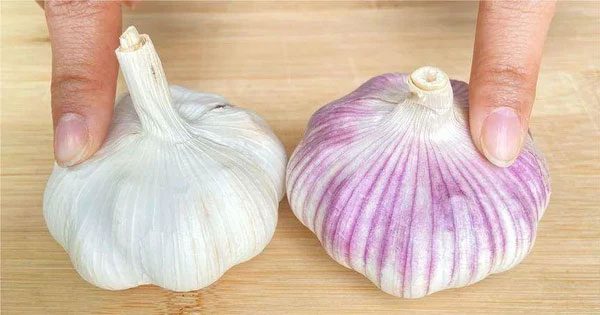Many people mistakenly believe that these two types of garlic are the same, but that is not the case.
When wandering through vegetable stalls, we can easily encounter two familiar types of garlic: white garlic and purple garlic. At first glance, they only differ in color, but in reality, they have distinct characteristics in terms of flavor and nutritional value.
1. Flavor
White garlic typically has a higher water content, resulting in a milder and less pungent taste compared to its “brother,” purple garlic. Therefore, white garlic is an ideal choice for direct consumption, enjoyed raw with dishes such as noodles, pho, boiled meat, etc., to enhance the delicious flavors and stimulate the palate.
In contrast, purple garlic possesses a stronger, spicier, and more aromatic flavor due to its lower water content. This is the “secret” that makes purple garlic the “soul” of stir-fried dishes, bringing a distinctive aroma.
2. Nutrition
Aside from their flavor differences, white garlic and purple garlic also “compete” in terms of nutrition. While both are rich sources of protein, fats, carbohydrates, vitamins, and minerals, purple garlic has an edge in certain specific nutrients.
Purple garlic is very high in anthocyanins, compounds that can combat oxidative stress in the body. Additionally, its allicin content is relatively high, providing good antibacterial effects. Therefore, incorporating purple garlic into a balanced diet is considered a key to enhancing health and preventing diseases.

Depending on your preferences and usage purposes, you can choose the appropriate type of garlic.
In summary, both white and purple garlic are excellent spices that add unique flavors to dishes and contribute to health protection. Depending on your preferences and usage purposes, you can choose the appropriate type of garlic. Remember these simple tips from this article to become an informed consumer and add more “character” to your family’s kitchen.
Tips for Long-Term Garlic Storage
To keep garlic bulbs dry and prevent spoilage, you can apply the following methods:
Store dry garlic in a cool, dry place: The most important factor in preserving dry garlic is to keep it in a low-humidity environment to prevent sprouting or mold. Store garlic at room temperature, avoiding direct sunlight. This can be done by placing garlic in a breathable basket or mesh bag, allowing air to circulate around the bulbs to keep them dry.
Use paper bags or cardboard boxes for storage: Wrapping garlic in paper bags or placing them in cardboard boxes helps absorb moisture, preventing mold. Paper bags also allow garlic to “breathe,” unlike sealed plastic bags that restrict airflow, which can cause garlic to rot faster.
Avoid metal contact: Prolonged contact between garlic and metal can lead to oxidation, affecting garlic quality. Therefore, try not to store garlic in metal containers.
Hang garlic: A traditional method is to hang dry garlic bunches in the kitchen or a dry, well-ventilated area. This method not only allows good air circulation around the garlic bulbs but also makes it easier to check for any signs of spoilage.

White garlic usually has a higher water content than purple garlic.
Use dry roasted salt: Roasted coarse salt can be used as a simple and effective method to keep dry garlic from spoiling. This not only helps absorb moisture in the garlic storage bag but also has antibacterial properties, thereby extending the shelf life of garlic. Simply prepare about 50-60 grams of large salt, roast it until it turns a beautiful golden color, then place it in a clean piece of gauze and tie it tightly. After that, put the garlic in and seal it tightly. Store the garlic bag in a place free from high temperatures, and you can preserve garlic for up to a year without worrying about spoilage or quality changes.
Regular checks: Although dry garlic can be stored for a long time, regular checks allow you to remove any bulbs that show signs of spoilage or sprouting, keeping the rest of the batch in better condition.
Implementing these methods will help you optimize your dry garlic storage, ensuring that your garlic remains in the best condition for use when needed.


















































